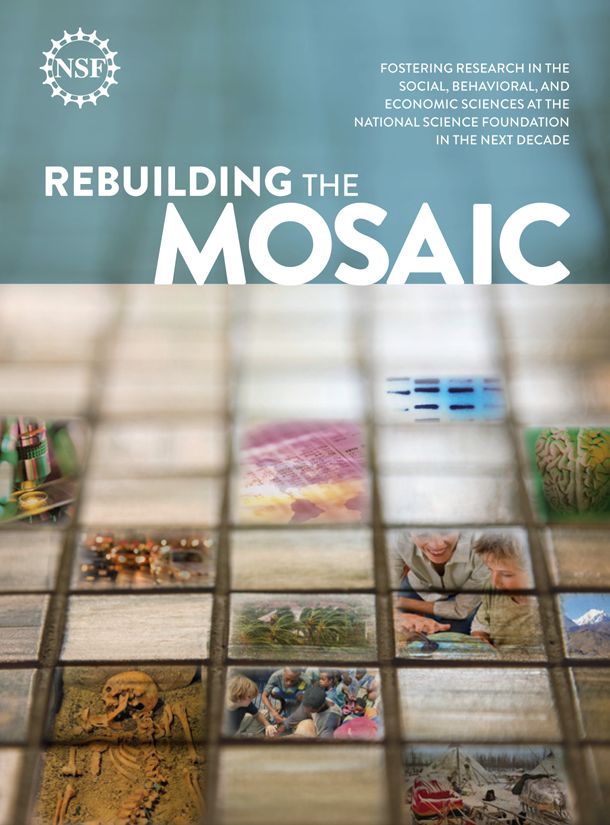By Erin Holaday Ziegler
The National Science Foundation's (NSF) Directorate for Social, Behavioral and Economic (SBE) Sciences recently announced the findings of a year-long study that just may be the future of federally-funded social science research.
This time, the submission process was different. Rather than completing applications for funding, the NSF wanted to start a conversation amongst the social sciences about its future through proposals from its own.
And so “Rebuilding the Mosaic: Fostering Research in the Social, Behavioral and Economic Sciences at NSF in the Next Decade” was born.
More than 252 teams of authors from the SBE community responded to the NSF call, which was the first of its kind. The University of Illinois contributed the most to “Rebuilding the Mosaic,” along with Harvard University. Illinois went so far as to hold a university wide search and discussion on the next ten decades in social science research.
"'Rebuilding the Mosaic' was different for the NSF,” said University of Kentucky sociology professor and contributor Tom Janoski. "But the overwhelmingly positive result of the proposals show that this type of crowd sourced input might be necessary for the future of global and technological research."
Although Janoski and colleagues in the UK sociology department were the only participants in “Rebuilding the Mosaic,” the unified and engaged response of academics around the nation begs the question: could social scientists at UK begin a conversation here in Lexington? What if UK’s College of Arts & sciences engaged in the same process?
Here’s what happened when Janoski and a fellow UK sociology professor Chris Oliver described future research needs in the sociology of labor markets:
Generation R: caught in the ‘vortex’

When Janoski asked his students about smart phone technology in the fall of 2010, they had nothing but positive things to say. “It was kind of like asking a student in the 1960s if there was anything wrong with rock ‘n roll,” Janoski said. “It was an accepted part of life.”
The widespread popularity of smart phone technology, as well as the virtual canonization of Steve Jobs isn’t altogether harmful, according to Janoski. Problems arise when young people fail to see the whole picture. The business practices of large, American companies, like Apple’s utilization of Chinese employees for manufacturing, have the ability negatively affect American job prospects.
Janoski’s informal student survey of “Generation R,” or “Generation Recession,” guided his work with fellow UK sociology professor Christopher Oliver, which eventually led to the creation of “The Vortex of Labor,” one of 252 NSF proposals included in “Rebuilding the Mosaic.”
It’s not just Apple.
In“The Vortex of Labor” Janoski discusses the effects of offshoring, lean production and advanced technologies on the jobs crisis in the U.S. His main contention is that “jobless recovery” is no longer a cyclical phenomenon like in economic downturns of the past. The Great Recession is different, as it is caused by the increasingly serious jobs crisis in sophisticated, developed countries.
“America is an advanced, industrialized country, and we have our heads in the sand,” Janoski said. “Successful U.S. companies affect quite a small percentage of our population financially. Their economic success stands alongside a society rife with some of the highest incarceration rates in the world, high inequality, underemployment and unemployment.”
The recessionary problem, Janoski argues, is not the US deficit, which is a secondary issue, but rather the trade deficit. “Our manufacturing deficit swamps the positive exports of services by a factor of five,” he explained. “The service sector cannot generate enough exports to make up for imports from Asia and elsewhere.”
Many U.S. corporations operate under renowned General Electric CEO Jack Welch’s 70%-70%-70% offshoring rule, which states that 70% of a company’s processes should be outsourced; 70% of these outsourced processes should be offshore; and 70% of all offshore outsourced processes should be performed in India. Welch also suggested that factories be built on barges so they could be moved to the countries that paid the lowest wages.
While Welch was made “Manager of the Century" by Fortune magazine in the mid-90s, and GE became the most valuable company in the world under his watch, someone had to pay for his behavior, and the consequences of a company like GE’s success can be found in Occupy Wall Street protests, in the U.S. debt downgrade and in large, outstanding debts to China, according to Janoski.
So, what should America do to solve her economic ills?
Janoski advises steps to increase the U.S. balance of trade. “We have to spend more time and energy producing goods within our own country,” he recommended. “You can’t export services.”
The first step is education. “The U.S. needs a skilled labor force,” Janoski said. “We have to change the structure. What’s does school mean for students that don’t attend college? They need options to learn a skill.”
Janoski references Germany’s apprenticeship program as a good model for the American education system to follow. “Students are highly skilled when they graduate from German schools, and as a result, the country has a constant supply of skilled labor,” he said. While the US could not copy the German system directly, we could send students not intending to go to college to vocational programs in the community colleges for their junior and senior years of high school.
In addition to educational reorganization, Janoski would raise the overall corporate tax rate and reevaluate the labor standards American politicians agreed to with the 1994 North American Free Trade Agreement (NAFTA). “Our government is promoting exploitation,” he said. “This doesn’t set a great example for the private sector. Why should these businesses stop, if they are more profitable?”
While questions remain, Janoski and his fellow NSF academics provide a sundry start. "Rebuilding the Mosaic" is available online at NSF's website together with all 252 white papers and supporting materials.
